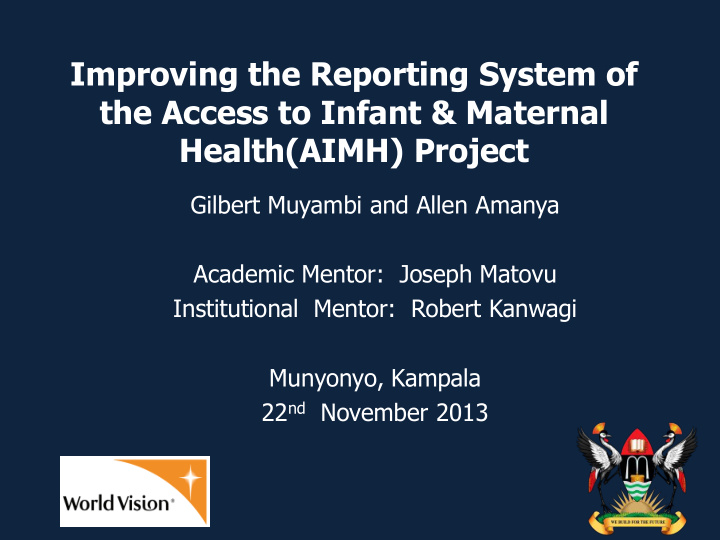



Improving the Reporting System of the Access to Infant & Maternal Health(AIMH) Project Gilbert Muyambi and Allen Amanya Academic Mentor: Joseph Matovu Institutional Mentor: Robert Kanwagi Munyonyo, Kampala 22 nd November 2013
"Some VHTs normally bring reports to my health facility when I am doing my work, and I don’t know what to do with these reports” The in charge Health Centre 11, Kasambya Kabale District
Background • Access to Infant and Maternal Health (AIMH) is a project intended to contribute to improving maternal and child health in Uganda • The project is piloting the timely and targeted counselling(ttC) model • The project is supporting “community module” six of the HMIS using VHTs to collect data • The project is implemented in six sub-counties in Kabale and Busia through the VHT structure • The project had challenges with reporting
Problem Analysis Cause Effect Problem Data flow Difficulty process not making defined informed decisions No data storage and management Poor Difficulty Reporting justifying System Inadequate models capacity of staff used Inadequate Difficulty reporting tools tracking progress Incomplete M&E plan
Project Objectives – To improve the reporting system of the AIMH project • To develop monitoring and data collection tools aligned to key project indicators • To develop a data use and management plan for the AIMH project • To build the capacity of AIMH project staff and partners in data management
Project Implementation Revision and Adoption of tools • Re(designed) project tools; the ttC register, ttC summary form into shorter easier formats • Harmonised the different existing reporting tools/registers into one from four tools • Adopted, printed and distributed HMIS tools; 095, 097, 106a forms • Developed the AIMH Project quarter reporting form
Capacity Building • Trained 30 district health officials on HMIS reporting • 887 VHTs trained on the use of HMIS tools by trained officials • Reporting roles and responsibilities drawn Health officials filling out forms during a and agreed upon training workshop
Improving data flow • Developed and disseminated data flow map with stakeholders • Designed a data base for storage and reporting
Data Flow Map Biostatistician Enter data into AIM quarterly District /HMIS focal system, World form person Vision picks data Summarizing focal Health HMIS106a Sub County person data & Assistant submit to district HMIS 097, ttC VHT focal Summarizing team summary form Parish person leader data HMIS 097/ttC Data summary for VHT team Village summary form VHTs leader VHT register/ Data collection VHT Households ttC register from HH
Achievements- Improved reporting • Proportion of VHTS reporting increased to 93% from 0% at baseline 93% 92% 94% 100% 90% 80% 70% 60% 50% 40% 30% 20% 0% 0% 0% 10% 0% Kabale Busia Total Baseline Current
Achievements Cont.. • Increased availability of quantitative data for periodic reporting • Available data informing project decision making e.g. due to data quality gaps, refresher training planned for VHTS.
AIMH Data Base Entry Screen
Female Children Under 5 Health, Busia ADPs, July - Sept. 2013 2096 2000 1745 76% 90% 1564 1566 74% 1500 CU5 Female 63% CU5 VitA Female 75% CU5 Dewormed Female 66% 65% 69% CU5 LLIN Female 1000 54% 52% 42% 500 14% 0 Busitema Lunyo Sikuda Busiime
Challenges • VHTS are still getting familiar with filling the data collection tools. • Inadequate supply of HMIS tools at health facilities. • Some VHTs have difficulty in reading and writing
Lessons • Utilizing existing government systems is more sustainable in improving Community HMIS reporting • Utilizing HMIS is as an ideal entry point for promoting project models
Next Steps • Reporting writing and feedback to different stakeholders • Partner with the districts to hold data quality assessments and mentorship
Conclusion • Most times projects struggle to build systems capable of providing data However, there are systems already in place • that can be improved and supported to meet government and partner data requirements • The success in improving VHT reporting from 0% to 93% is a clear demonstration of a true health systems strengthening approach
Acknowledgements • Makerere University School of Public Health • District health officials and Village Health Teams • Academic mentor; Joseph Matovu and Institutional mentor Robert Kanwagi • Management and staff of World Vision Uganda
Recommend
More recommend